Dogs without hair simply have a disposition for hairlessness or hair loss in their genes. This means they exhibit bare skin all over their body or on most parts.
There are two types of bald dog breeds, recognized and Non-registered dogs. Worldwide recognized breeds that are hairless are only five, they include the Peruvian Inca Orchid, Mexican hairless dog-Xoloitzcuintle, Chinese Crested Dog, Ecuadorian Hairless Dog, and the American Hairless Terrier. As for the non-registered dogs, there is the Argentine Pila Dog, Abyssinian Sand Terrier, hairless Chihuahua, and the Bolivian Hairless Dog.
Undoubtedly, there are other non-registered dogs like the Egyptian Hairless Dog, the Elephant Dog, and the Siamese Hairless Dog, however, not much information is available about them. Some consider the lack of fur ugly while others adore it. Nonetheless, below is a detailed look at the most common hairless dog breeds in the world.
Peruvian Hairless Dog
The Peruvian Inca Orchid, also known as the Chimu dog is a pet dog native to Peru. Also comes in two varieties, namely coated and hairless, but according to the FCI breed standards, the hairless type is the only one recognized.
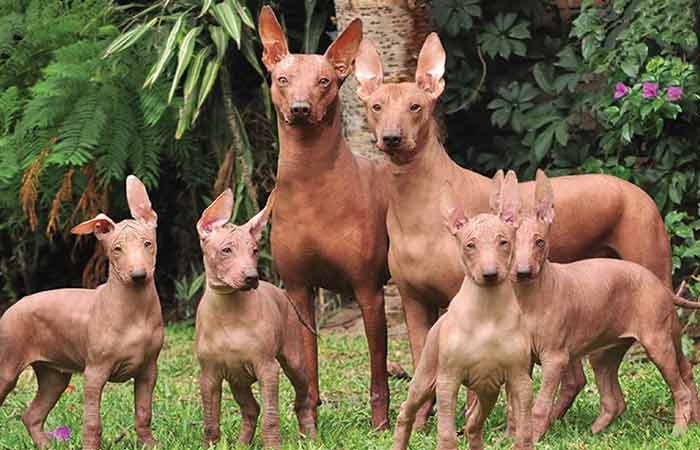
The Peruvian viringo comes in three sizes, from small, medium to large weighing approximately 30 pounds and has an average height of 20 inches. The hairless naked dog is mainly characterized by lack of hair or short hair on its feet, the tip of the tail, and top of its head.
It can have multiple skin colors ranging from copper, mottled, chocolate brown, or elephant grey. There are cases of albinism, but it’s not a breed standard.
More about the Peruvian Inca Orchid is that the dog has a slim and elegant appearance, tough and harmonious with candle flame-shaped ears that are almost erect. The dog also has a lively temperament. Very keen and agile. Alert to respond to stimuli. Very fast learners and hunters. However, they need a lot of care due to their exposed bare skins. Grooming and warm clothing is a major requirement to keep them healthy.
Mexican Hairless Dog-Xoloitzcuintle
Next up is the Xoloitzcuintle also known as the Mexican hairless dog. Belonging to the toy family as well, it’s most notable characteristic has to be its hairlessness followed by wrinkles and dental abnormalities exhibited by all the other hairless breeds.

The Xolo has an average height of 15 inches and an average weight of 40 pounds. It can be found in three sizes from toy, miniature, and medium-sized dogs. It has a sleek appearance, large bat ears, a long neck, almond-shaped eyes, a slim body as that of a Pharaoh Hound, and a very dominating gene of hairlessness.
As with the crusted dog, they have two types of the Xolo, coated and completely hairless. The coated variety has a short, flat, and dense coat while the hairless doesn’t have a single fur on its body, well, probably a few on its head, toes, and the tip of the tail.
To further differentiate between the coated and hairless Xoloitzcuintle, look out for the incomplete dentition which mean the presence of the hairless dominant gene.
Peruvian Hairless Dog vs Mexican Hairless Dog
The peruvian and Mexican hairless dogs are easily confused for each other. Following are the differences and similarities of these two popular hairless pooches.
| Peruvian Hairless | Mexican Hairless | |
| Origin | Peru | Mexico |
| Group | Miscellaneous | Non-sporting |
| Other Names | Peruvian Inca Orchid, Perro Sin Pelo de Perú, Inca Hairless Dog | Xolo, Mexico Xolo |
| Energy Level | Energetic hence more exercise needs | Medium; low amount of exercise |
| Life Span | 10-12 | 12-20 |
| Colors | Grey, mottled, Dark brown | Bronze or tan, Shades of Grey |
| Coat | Hairless except for some hair on the head | Hairless |
| Litter Size | 3-5 | 2-5 |
| Dander | Dander-free | Minimal |
Apart from the few differences, the two breeds do have a couple of similarities.Both the peruvian are hypoallergenic medium-sized breeds. They get along with all animals and children. The dogs are excellent companions, ideal for keeping at home, they are clean and odorless.
They are easy to train, requirements range from low to moderate
Ugly Hairless Dog-The Chinese Crested
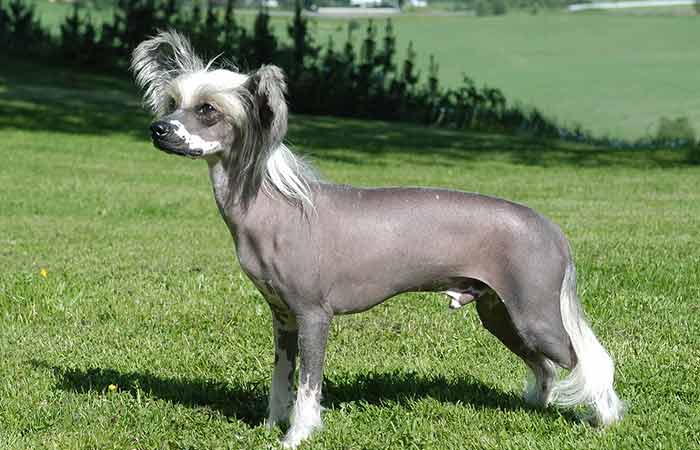
The Chinese Crested Dog has distinct looks that make it stand out. It has spotted skin, crested hairdo, furry socks and feathery tail.
By far, in terms of appearance, the bald variety and its mixes have been voted as the ugliest dogs in the world; only their owners liked them. In one way or another, the are still champs in their own way. Well, it all depends on how you look at them. Some people still love these canines.
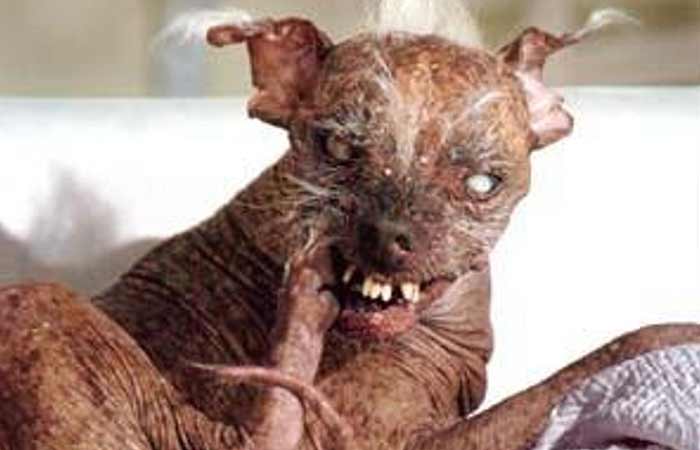
This dog breed comes in two varieties, with and without fur also known as the Powderpuff and the Hairless.Belonging to the toy family, the hairless crusted dog weighs only 10 pounds, approximately 4.5 to 5.9 kg. With an incomplete dominant hairless trait, the crusted dog has a soft and smooth like skin visible mostly around the chest and back.
By incomplete it means the dog has patches of hair in selected areas including the paws which have tufts of fur, the tail, and even the head could have flowing hair.
A true hairless crusted dog will ideally not have any hair, but because most are heterozygous, meaning having a mix in traits, it’s not uncommon to see dogs with fur around the muzzle like a beard.
The major difference between the Powderpuff and hairless crusted dogs is that the Powderpuff has a thick double coat while the hairless only has a single coat. It also has a variety of colors from pale flesh to black.
Ecuadorian Hairless Dog (Perro Calvo dorado ecuatoriano)
In Ecuador, specifically the Santa Elena Peninsula, there is the Ecuadorian Hairless Dog. One of the rarest recognized hairless breeds with a medium height of 15 to 18 inches.
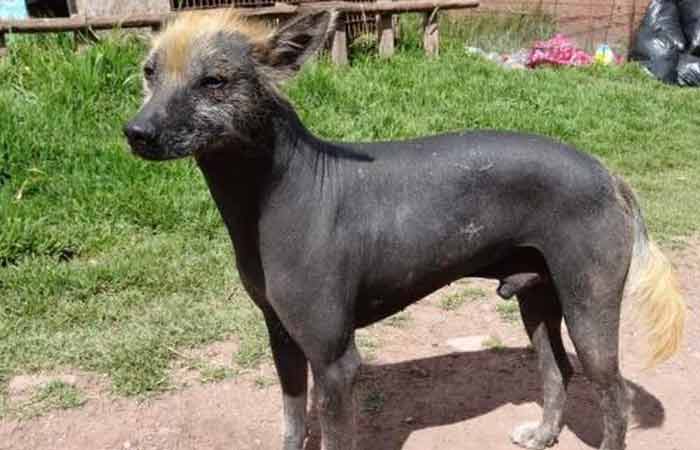
The Ecuadorian dog is characterized by the obvious hairless body and head, the dog also has long legs and the absence of premolar teeth, a common curiosity among the hairless dogs.
American Hairless Terrier
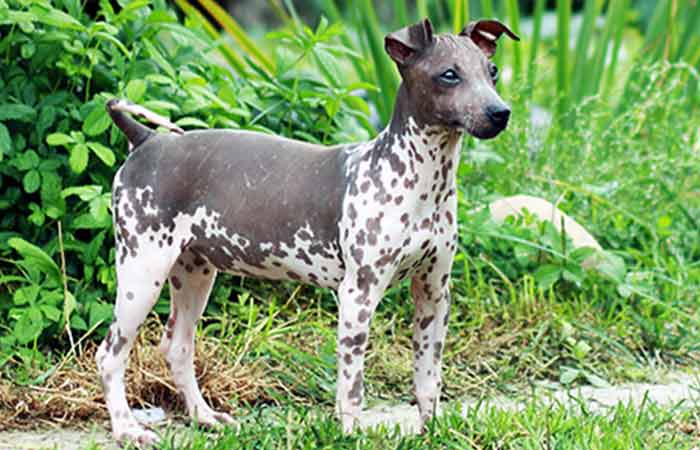
Last but not the least, the American Hairless Terrier, acronym AHT, is the only breed that possesses a recessive hairless gene.
This means while other dog breeds with a dominant gene can have health, skin, or dental issues, AHT doesn’t. Distinguishing features about this Terrier besides lack of fur is its eat foundation stock, multiple colors, and availability in different sizes.
As with the other breeds above, the American Hairless Terrier also has a coated variant that has a short dense coat recognizable by everyone.
Non-Registered Bald Dog Breeds
Abyssinian Sand Terrier (African Hairless Dog)
The Abyssinian Sand Terrier, otherwise known as the African Hairless Dog is one of the oldest hairless breeds in the world. With only just a few patches of hair on their heads and tail, they are completely hairless otherwise. They have a varied skin tone from dull pink, to blotches of pink, grey, and other random colors depending on the nature of breeding.
Even with their bare skin, they only require minimal grooming to avoid skin dryness and other skin diseases like cancer.
Argentine Pila Dog
Also known as the bald dog, the Pila is a completely hairless dog that is very rare to find leave alone locate. They have smooth human skin all over besides their whiskers, tail, feet, and on their heads. Believed to be an ancestor of the Peruvian Inca Orchid, it’s yet another prime candidate for missing teeth and not only premolars but more.
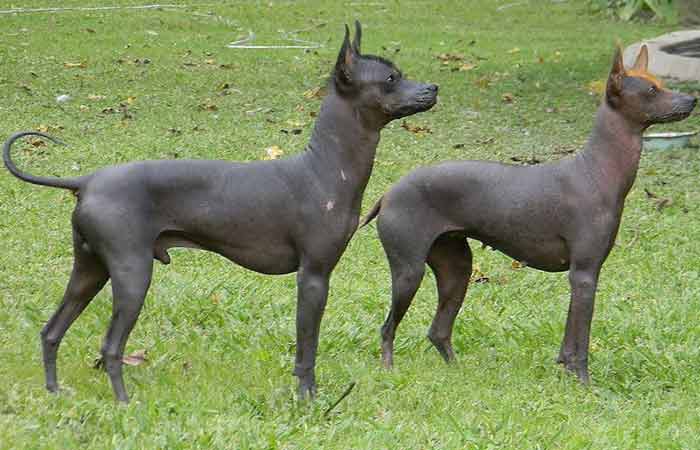
Being hairless is not the only fun fact about the Argentine Pila, these companion dogs are aphonic hence, don’t expect them to bark as they can produce sound. Besides that, they are excellent watchdogs and even companions for families.
Bolivian Hairless Dog (Hairless Khala)
Another hairless dog comes from Bolivia, the hairless Khalas, which come in two kinds;
- Hairless Khala Medio (short-legged)
- Hairless Khala Grande (long-legged).
The Khala Medio is a medium-sized dog that’s more powerful than the Khala Grande. However, the long-legged khala is faster and has greater agility. Both khalas are purely hairless with most having a dark grey skin color.
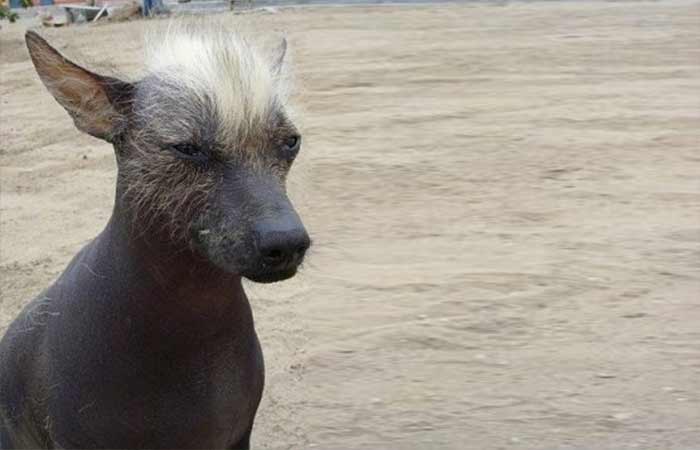
The Bolivian Hairless Dog has a gentle and sweet temperament, unkind to strangers, but very friendly to owners. If you need a hypoallergenic dog, this would be a great fit.
Hairless Chihuahua
Lastly, the hairless Chihuahua is nothing different from the ordinary Chihuahua we all know and love. Recently, breeders have been breeding hairless Chihuahuas in an attempt to produce one with specific skin color or colored coat.
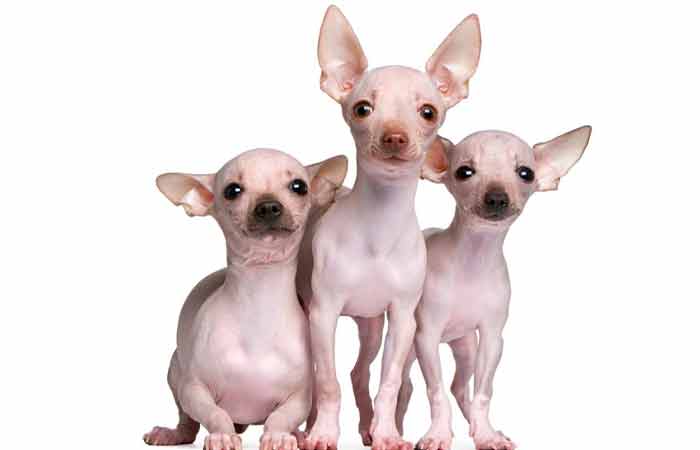
So if you love the Chihuahua but dislike its shedding habits, then this would be the solution you’ve been looking for. This particular Chihuahua has the same behavioral traits as the ordinary type, however, this one may need more care especially grooming the skin. Leaving them this exposed can harm them or expose their skin to dangerous diseases.
What are the Reasons Behind having No Hair?
Scientifically, a hairless dog is said to have reached its telogen phase, which simply means a resting phase where all the hair it once had shed off leaving them bare. But, in this case, the hairless dog breeds are actually born without hair so it has nothing to do with aging.
Genetic hairlessness comes from two known types;
- Dominant
- Recessive
The dominant hairless trait is caused by ectodermal dysplasia which comes about as a result of a mutation of the FOXI3 autosomal gene, which is responsible for the growth of teeth and fur cells. Explain why these hairless dog breeds also don’t have teeth or fewer teeth than typical dogs.
To further understand this, ectodermal dysplasias is a rare inherited disease also found in humans that affects multiple cells in the body. This includes sparse hair, a dental problem, nail defects, skin issues, and even sweat gland defects. This mutation is what is seen as a dominating or recessive gene in dogs, what’s called the FOXI3 gene.
Hairless Dogs Grooming Tips
Dogs and other fur-coated animals use their hair and fur for multiple reasons including keeping warm, protect against skin diseases, control body temperature among many reasons. Now without the hair, hairless dog breeds have to be groomed to compensate for the same. Here are a few grooming tips you could use.
Moisturize Their Skin
Their bare skin emulates that of a human meaning their skin needs regular moisturizing. Keeping skin oiled will prevent dryness, acne, sunburns, and other skin-related issues. Go for hypoallergenic and oil-free moisturizing cream after bathing them to keep their skin from drying out.
Especially if your dog is light skin or blotched, oil is a major grooming need. Check the ingredients of the oil to check if it’s safe. Avoid lanolin as some breeds like the Chinese Crested Dog is allergic to it. Go for simple oils like olive oil, sunflower oil, coconut oil, or even vegetable oil.
Groom Regularly
Grooming is not just about brushing their skin and whatnot. It’s about bathing them and generally taking care of their skin. Here are easy and simple ways to ensure your dog is groomed properly;
- Shave them occasionally – especially for the Chinese Crested Dog and the Peruvian Inca Orchid, they have quite a tuft of hair on specific areas. You could remove those for even skin.
- Regularly bathe your dog as its way easier now. Bathe to remove dirt and to prevent clogging of pores which further leads to blackheads. You can use baby cleaners as they don’t contain lanolin.
- Use a soft brush over their skin.
- Wipe them down with a soft damp microfiber cloth after their bath.
- Clean their ears at least weekly.
- Trim their nails regularly
- Brush their teeth with a soft and gentle toothbrush even though they don’t have a complete set of teeth.
- Don’t squeeze out any pimples or blackheads as it could easily lead to infections.
- Always consult with your veterinarian about good quality products to use on your dog.
Use Sunscreen
Exposure to the sun can be a harmful ordeal for your dog. Not only to light-colored dogs but all the hairless dogs. The sun has harmful UV rays that have radiation causing the skin to have sunburns. This is why you need to use sunscreen on their skin. Select a high-quality sunscreen to use on your dog. If you don’t know any, consult with your veterinarian.
Cover Them Up
No hair simply means no insulation, hence your dog is prone to feel cold. In fact, adverse weather conditions can cause the dog to feel limited as they can easily freeze in the cold. More especially for smaller dogs, they feel the effects of cold weather more intensely than larger dogs.
It’s therefore, your responsibility to cover them up in something warm to keep their temperament at least above 15 degrees Celsius. A mavin is also great to cover their ears that are also affected by the cold. A sweater and a mavin should be enough.
Go the Extra Mile
Going the extra mile means checking on their bedding to see if it needs changing. Having bare skin also exposes them to the same skin issues as yours. Therefore, dirty bedding can cause them to have irritable skin.
Hairless dogs are great to have around. At least with them, you’re assured they’re hypoallergenic and won’t cause allergies or fleas. However, care is mandatory, precisely, skincare.
More on Dog Fur
- Long-haired Dog Breeds
- Shih Poo Haircut Ideas + Pictures
- Dogs that Don’t Shed: Small and Large Breeds
- Dog Breeds with Double Coats
- Dogs with Single Coats
- Triple Coat Dog Breeds
- Wiry-Haired Dogs
- Dog Grooming Brush Types
- How Fast Does Dog Hair Grow Back after Shaving?
Sources
- https://en.m.wikipedia.org/wiki/Hairless_dog
- https://en.m.wikipedia.org/wiki/American_Hairless_Terrier
- https://en.m.wikipedia.org/wiki/Ecuadorian_Hairless_Dog
- https://en.m.wikipedia.org/wiki/Peruvian_Hairless_Dog
- https://en.m.wikipedia.org/wiki/Chinese_Crested_Dog
- https://en.m.wikipedia.org/wiki/Xoloitzcuintle






